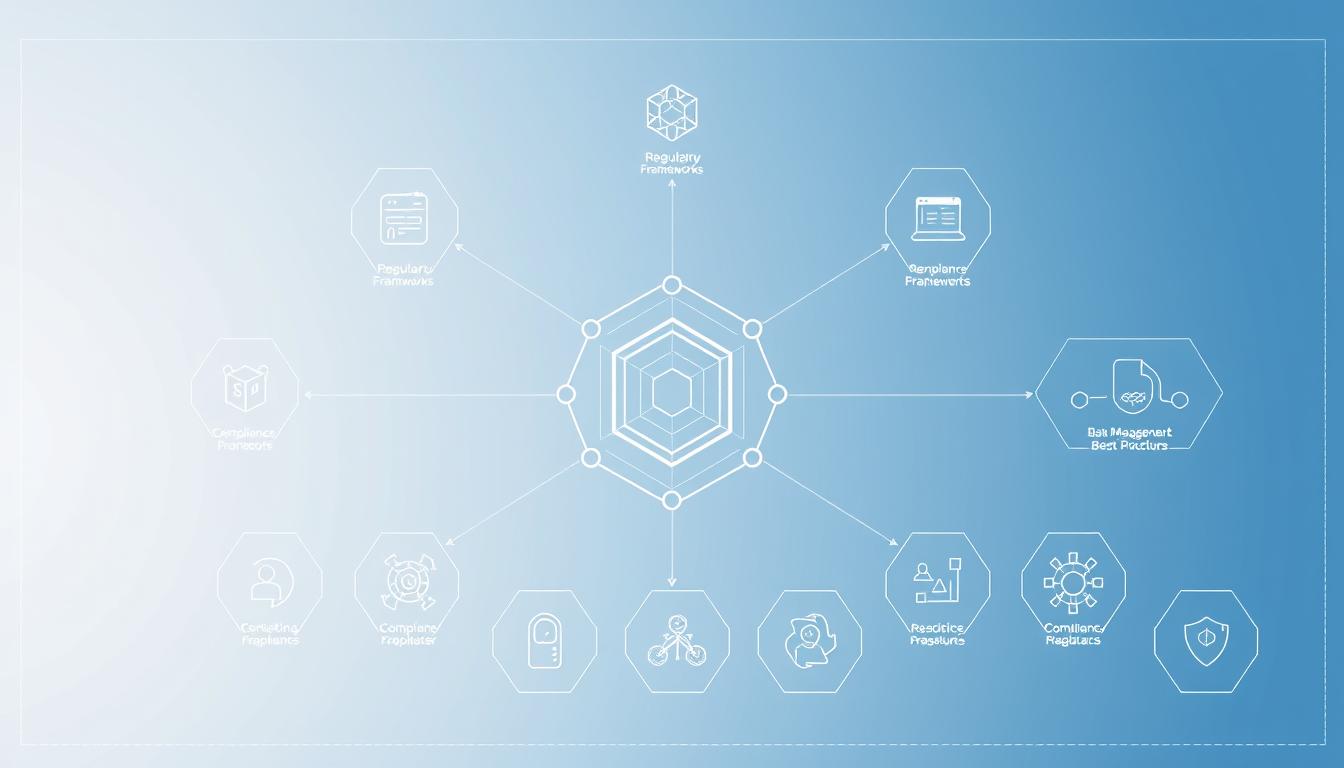Now Reading: Blockchain Compliance: Navigating Regulatory Requirements
- 01
Blockchain Compliance: Navigating Regulatory Requirements
Blockchain Compliance: Navigating Regulatory Requirements

As decentralized systems reshape industries, organizations face a critical balancing act: leveraging innovation while adhering to evolving rules. Governments worldwide are tightening oversight of digital assets, creating complex hurdles for businesses using distributed ledgers. Staying ahead demands more than basic adherence—it requires strategic foresight.
Crypto platforms and enterprises now grapple with fragmented standards across jurisdictions. For example, U.S. agencies like the SEC and CFTC enforce overlapping mandates, complicating cross-border transactions. These crypto regulatory challenges force teams to rethink risk management without sacrificing operational efficiency.
A robust blockchain compliance framework isn’t optional—it’s foundational. Proactive organizations map obligations early, integrating audits and real-time monitoring into system designs. This approach preserves core advantages like transparency while minimizing legal exposure.
Key Takeaways
- Global standards for distributed ledger regulations remain inconsistent, requiring localized strategies
- Cross-agency oversight in the U.S. creates unique compliance complexities
- Automated monitoring tools reduce human error in transaction reporting
- Early legal consultation prevents costly redesigns post-deployment
- Privacy-focused designs align with regulations like GDPR while maintaining decentralization benefits
Why Blockchain Compliance Matters in Modern Business
As blockchain technology reshapes industries, regulatory agencies are intensifying efforts to control its risks without stifling progress. This balancing act creates critical challenges for businesses using distributed ledgers – challenges that demand proactive compliance strategies.
The Growing Regulatory Scrutiny of Distributed Ledgers
U.S. regulators have tripled blockchain-related investigations since 2021. The SEC now dedicates 20% of its cybersecurity budget to crypto oversight. Recent actions show a pattern:
- FATF compliance requirements expanding to cover DeFi platforms
- SEC lawsuits targeting unregistered security offerings
- OFAC sanctions against mixers like Tornado Cash
Major exchanges now spend 40% more on legal teams than in 2020. The 2022 Blockchain Transparency Report revealed 78% of firms modified their protocols to meet evolving standards. This trend shows no signs of slowing – New York’s DFS just introduced stricter crypto listing rules in Q1 2024.
Consequences of Non-Compliance: Fines vs Innovation Stifling
Regulatory penalties come in two forms: direct financial hits and indirect innovation barriers. Compare these 2023 outcomes:
| Case | Fine | Operational Impact |
|---|---|---|
| SEC vs Kraken | $30 million | Discontinued staking services |
| FinCEN vs Bittrex | $24 million | Exited US market |
While decentralized finance risks remain real, over-regulation threatens progress. Startups now allocate 35% less funds to R&D due to compliance costs. The key lies in adaptive frameworks – Coinbase’s Travel Rule solution demonstrates how tech can meet FATF standards without centralization.
Blockchain Technology Regulatory Compliance Requirements
Navigating blockchain compliance demands requires understanding two critical frameworks: anti-money laundering (AML) standards and know-your-customer (KYC) protocols. These systems form the backbone of regulatory efforts to prevent financial crimes while supporting blockchain innovation.
Anti-Money Laundering Directives Implementation
Financial regulators now require blockchain platforms to implement AML safeguards comparable to traditional banks. The 2021 FATF guidance expanded these rules to cover decentralized exchanges and NFT marketplaces.
FATF Travel Rule for Virtual Asset Service Providers
The FATF Travel Rule mandates that Virtual Asset Service Providers (VASPs) share sender/receiver information for transactions over $3,000. Compliance tools like Elliptic’s Navigator platform automatically encrypt and transmit required data fields without compromising blockchain efficiency.
Transaction Monitoring Systems for Crypto Networks
Real-time chainalysis monitoring solutions flag suspicious patterns across 24+ blockchains. Major exchanges like Coinbase use these systems to detect:
- Unusual withdrawal spikes
- Mixer service interactions
- Darknet market linkages
Know Your Customer Protocols for Decentralized Systems
Implementing crypto KYC solutions presents unique challenges in permissionless environments. TRM Labs reports 68% of DeFi platforms now use hybrid verification models to balance privacy and compliance.
Identity Verification Challenges in Permissionless Blockchains
Public blockchains struggle with pseudonymous wallet addresses that bypass traditional ID checks. Emerging solutions include:
- Zero-knowledge proof credentials
- Biometric blockchain oracles
- Reputation-based scoring systems
On-Chain vs Off-Chain Data Management Solutions
Compliance teams face critical decisions about storing sensitive information:
| Approach | Advantages | Risks |
|---|---|---|
| On-Chain | Transparent audit trails | Permanent data exposure |
| Off-Chain | GDPR compliance | Centralization concerns |
Data Privacy Regulations Impacting Blockchain Deployments
Blockchain’s promise of permanent data storage clashes directly with modern privacy laws demanding user control over personal information. This tension creates unique compliance hurdles for enterprises adopting distributed ledger technology. Let’s examine two critical regulatory battlegrounds where immutable records meet evolving data protection standards.
GDPR Right to Erasure vs Immutable Ledgers
Europe’s General Data Protection Regulation (GDPR) grants individuals the “right to be forgotten” – a direct contradiction to blockchain’s unalterable transaction history. Financial institutions using public ledgers face particular risks when handling EU citizen data. Zero-knowledge proofs emerge as a game-changer here, allowing validation of transactions without exposing personal details.
Healthcare blockchain implementations showcase practical workarounds:
- Private permissioned networks with modifiable metadata layers
- Off-chain storage of sensitive data with on-chain hash verification
- Time-limited encryption keys for legacy medical records
A 2023 Deloitte study revealed 68% of GDPR-compliant blockchain projects use hybrid architectures. These systems separate immutable core transactions from editable ancillary data, satisfying both audit requirements and deletion mandates.
HIPAA Compliance for Healthcare Blockchain Applications
Medical organizations exploring blockchain face strict Health Insurance Portability and Accountability Act (HIPAA) rules. Patient health information (PHI) requires healthcare data encryption at rest and in transit – a challenge for transparent ledgers. Emerging solutions include:
| Technology | HIPAA Requirement Addressed | Implementation Example |
|---|---|---|
| Private Subnets | Access Controls | Hyperledger Fabric channels |
| Homomorphic Encryption | Data Privacy | Duality Technologies platform |
| Multi-Party Computation | Audit Integrity | Sepior healthcare trials |
Mass General Brigham’s 2022 pilot demonstrated HIPAA-compliant blockchain for clinical trials. Their system uses immutable records compliance through encrypted patient consent logs while allowing redaction of incidental Protected Health Information (PHI) in audit trails.
Securities Law Considerations for Tokenized Assets
Navigating securities regulations remains one of the most complex challenges for blockchain projects offering digital assets. The SEC’s evolving approach to tokenized securities combines decades-old legal tests with modern enforcement strategies. Two critical frameworks dominate this space: the Howey Test for classifying assets and exemption pathways under Regulations D and A+.
Howey Test Application to Crypto Offerings
The SEC uses the Howey Test to determine if a crypto asset qualifies as a security. This 1946 Supreme Court precedent evaluates four criteria:
- Investment of money
- In a common enterprise
- With expectation of profits
- Derived from others’ efforts
Recent enforcement actions show strict interpretation. In the SEC vs Ripple Labs case, the agency argued XRP sales to institutional buyers met all Howey factors. The court partially agreed, creating new compliance gray areas for token issuers.
| Case Study | Howey Factors Met | SEC Ruling |
|---|---|---|
| Telegram’s GRAM Token | All 4 factors | $1.2B settlement |
| Block.one’s EOS ICO | 3 factors | $24M penalty |
| Coinbase Lend Program | 2 factors | Program canceled |
SEC Regulation D vs Regulation A+ Compliance Paths
Projects seeking legal token sales often use these exemption pathways:
| Feature | Regulation D | Regulation A+ |
|---|---|---|
| Investor Type | Accredited only | General public |
| Fundraising Limit | Unlimited | $75M/year |
| Disclosure Requirements | Minimal | Full prospectus |
Regulation D Checklist:
- Verify investor accreditation status
- File Form D within 15 days
- No general solicitation (Rule 506c exception)
Regulation A+ Advantages:
- Allows retail investor participation
- Tokens become freely tradable post-sale
- Enables testing of market demand
Tax Compliance Challenges in Blockchain Transactions
Blockchain’s decentralized nature creates unique tax reporting hurdles, particularly for users managing multiple wallets or participating in DeFi protocols. Navigating IRS guidelines while maintaining accurate records requires specialized tools and methodologies. Below, we break down critical compliance areas and compare leading solutions.
Understanding IRS Virtual Currency Reporting Rules
The IRS classifies cryptocurrencies as property, requiring taxpayers to report every disposal event. This includes trades, payments, and even decentralized finance (DeFi) interactions. Form 8949 preparation becomes complex when tracking hundreds of transactions across exchanges and self-custody wallets.
Key requirements include:
- Reporting capital gains/losses for each transaction
- Using FIFO accounting (First-In-First-Out) by default unless another method is formally elected
- Disclosing crypto holdings exceeding $10,000 in foreign accounts via FBAR filings
Crypto tax software like CoinTracker automates IRS-compliant reports by syncing exchange APIs and wallet addresses. TaxBit offers audit defense features, crucial for high-volume traders.
Managing Cost Basis Across Wallets
Tracking acquisition dates and prices becomes chaotic when assets move between cold storage, DeFi pools, and centralized platforms. A single NFT purchase might involve funds from three wallets, each with different cost bases.
Leading tools address this through:
- Automated wallet address scanning
- Cross-chain transaction reconciliation
- Customizable accounting methods (FIFO, LIFO, HIFO)
| Feature | CoinTracker | TaxBit | Koinly |
|---|---|---|---|
| DeFi Support | 500+ Protocols | 300+ Protocols | 400+ Protocols |
| FIFO Accounting | Yes | Yes (with LIFO option) | Yes |
| Multi-Wallet Sync | Unlimited | 20 Wallets | Unlimited |
| Form 8949 Automation | Full | Partial | Full |
TaxBit’s enterprise-grade API suits institutional investors, while Koinly’s intuitive interface benefits casual users. All three platforms integrate with TurboTax and support FIFO accounting blockchain workflows.
Smart Contract Legal Enforceability Issues
Self-executing agreements built on blockchain networks face unique legal challenges as global regulators grapple with their binding nature. The tension between immutable code and flexible legal standards creates uncertainty for enterprises adopting this technology.

Code as Law vs Traditional Contract Frameworks
Smart contracts operate on a “if-then” logic that leaves little room for human interpretation. This clashes with traditional contract law principles like:
- Mutual mistake doctrine
- Impossibility of performance
- Good faith negotiations
A 2023 Delaware Court of Chancery ruling involving a DAO treasury dispute established that courts may evaluate the intent behind code execution, not just the technical outcome. This precedent highlights the growing need for smart contract compliance strategies that bridge technical and legal requirements.
Dispute Resolution Mechanisms for DAOs
Decentralized Autonomous Organizations (DAOs) face jurisdictional challenges when conflicts arise. Emerging solutions include:
- On-chain arbitration protocols like Kleros
- Hybrid mediation systems using oracles
- Binding smart contract escrows
The Wyoming DAO LLC Act provides a template for DAO legal structure by requiring dispute resolution clauses in founding documents. Recent cases show courts favoring platforms with clear oracle dispute resolution layers that document human-readable transaction intent.
Global vs US-Specific Regulatory Approaches
Blockchain companies face a fragmented regulatory landscape where international standards clash with domestic rules. Understanding these differences helps businesses avoid legal pitfalls while maintaining cross-border operations. This section breaks down critical frameworks shaping crypto compliance today.
Comparing FINRA Guidelines with EU’s MiCA Framework
The Financial Industry Regulatory Authority (FINRA) and Europe’s Markets in Crypto-Assets (MiCA) regulation represent opposing approaches to oversight. FINRA focuses on broker-dealer compliance through strict reporting and investor protection measures. MiCA prioritizes market stability with unified rules for all 27 EU member states.
| Criteria | FINRA (US) | MiCA (EU) |
|---|---|---|
| Scope | Broker-dealers & securities | All crypto service providers |
| Capital Requirements | $150k minimum | €150k – €350k |
| Transaction Reporting | Daily trade logs | Real-time ledger |
| Enforcement | Case-by-case penalties | Standardized fines |
US firms operating in Europe must track MICA regulation timelines starting March 2025. The EU framework requires proof of reserves for stablecoin issuers – a rule absent from current FINRA guidelines.
State-Level Variations in Crypto Licensing (NYDFS vs Wyoming)
America’s state-driven system creates compliance hurdles for nationwide crypto services. New York’s BitLicense remains the strictest regulatory regime, while Wyoming offers blockchain-friendly charters.
| Feature | NYDFS BitLicense | Wyoming SPDI Charter |
|---|---|---|
| Application Fee | $5,000 | $500 |
| Processing Time | 18-24 months | 90 days |
| Capital Reserve | $10M minimum | $500k minimum |
| AML Checks | Third-party audits | Self-certification |
Wyoming’s crypto state legislation allows companies to tokenize traditional assets legally – a breakthrough for emerging crypto regulations. New York’s approach favors institutional players, requiring $1M surety bonds for BitLicense compliance.
These regional differences force multi-state operators to maintain separate compliance teams. Some firms adopt Wyoming’s framework for product development while using NY licenses for market access.
Compliance Automation Tools for Blockchain Networks
As regulatory demands intensify, blockchain enterprises are turning to automated solutions to streamline compliance processes. These blockchain analytics tools combine advanced algorithms with real-time monitoring to address evolving requirements while maintaining operational efficiency.

Chainalysis Reactor for Transaction Monitoring
Used by 70% of top crypto businesses, Chainalysis Reactor provides granular visibility into blockchain transactions. The platform reduces false positives by 40% compared to manual methods through its dual-layer analysis approach.
Address Clustering Techniques
The tool groups related wallet addresses using behavioral pattern recognition and UTXO analysis. This helps compliance teams:
- Identify nested service providers
- Track cross-chain fund movements
- Detect mixer-related transactions
Risk Scoring Algorithms
Chainalysis employs machine learning models that assess transaction risk assessment factors including:
- Counterparty jurisdiction (weight: 35%)
- Transaction history anomalies (weight: 25%)
- Darknet market associations (weight: 40%)
Elliptic Navigator for AML Compliance
Elliptic’s platform processes 15 million transactions daily, integrating directly with node infrastructure. Its OFAC screening crypto capabilities update every 90 seconds to reflect global watchlist changes.
Wallet Screening Workflows
The system automatically flags high-risk wallets through:
- Proprietary entity mapping database
- Cross-referenced IP geolocation data
- Historical sanction exposure tracking
Sanctions List Integration
Elliptic maintains direct API connections to 23 regulatory databases, including:
- OFAC Specially Designated Nationals (SDN) list
- EU Consolidated Financial Sanctions List
- UN Security Council Resolutions
Real-World Compliance Implementation Case Studies
High-profile legal battles and regulatory adaptations offer critical lessons for blockchain enterprises navigating compliance landscapes. This section examines two landmark cases that reshaped operational strategies across the industry.
Ripple Labs’ SEC Litigation Compliance Strategy
The Ripple vs SEC lawsuit fundamentally changed how crypto companies approach securities law compliance. When regulators alleged XRP was an unregistered security, Ripple executed a three-phase response:
- Immediate suspension of XRP sales to U.S. institutional investors
- Creation of geo-fenced transaction protocols
- Public release of real-time liquidity metrics
These measures reduced regulatory exposure while maintaining global operations. Ripple’s On-Demand Liquidity service underwent 14 compliance upgrades during litigation, including:
- Automated securities law checks for cross-border payments
- Enhanced transaction metadata recording
- Third-party custody partnerships for escrowed XRP
The case demonstrates how proactive compliance adjustments can preserve business continuity during legal challenges. Ripple’s compliance team grew 300% post-lawsuit, reflecting increased focus on regulatory alignment.
Binance.US Adaptation to FinCEN Requirements
Facing BSA compliance crypto mandates, Binance.US overhauled its operations through three key initiatives:
- Implementation of AI-powered transaction monitoring (10,000+ suspicious activity reports filed in 2023)
- Mandatory KYC verification for all trading tiers
- Daily wallet address screening against OFAC lists
The exchange’s regulatory adaptation included structural changes like:
- Separating U.S. customer funds from global operations
- Adopting Travel Rule compliance software
- Establishing a 24/7 regulatory response team
These measures enabled Binance.US to meet FinCEN’s evolving requirements while maintaining market share. The 2023 settlement agreement highlights the importance of preemptive compliance upgrades in decentralized finance ecosystems.
Emerging Regulatory Trends in Blockchain Governance
Blockchain governance is entering uncharted territory as regulators and developers collaborate on frameworks that balance innovation with accountability. Two groundbreaking approaches are redefining compliance: decentralized finance (DeFi) liability structures and central bank digital currency (CBDC) architecture designs. These models address critical challenges in accountability and user verification while maintaining core blockchain principles.

DeFi Protocol Liability Shifting Models
Decentralized finance platforms face unique legal challenges due to their lack of centralized control. New liability models are emerging to address regulatory concerns while preserving decentralization:
- DAO-based governance frameworks that distribute decision-making across token holders
- Algorithmic compliance checks embedded in smart contract code
- Insurance pools funded by protocol revenues to cover potential liabilities
Regulators now examine how algorithmic regulation tools automatically enforce transaction limits and screen suspicious activity. The table below compares three emerging liability management approaches:
| Liability Model | Key Feature | Regulatory Impact |
|---|---|---|
| DAO Governance | Community voting on protocol changes | Shifts liability to token holders |
| Insurance Fund | Protocol-managed risk pool | Reduces user exposure to smart contract failures |
| Legal Wrapper | Off-chain entity for dispute resolution | Provides clear jurisdiction for regulators |
Central Bank Digital Currency Compliance Frameworks
National digital currencies require robust compliance features without compromising transaction efficiency. Leading CBDC projects implement:
- Programmable money with built-in KYC verification tiers
- Real-time transaction monitoring through regulatory nodes
- Automated tax reporting protocols
The Federal Reserve’s digital dollar prototype demonstrates how embedded compliance works in practice. Its layered architecture separates identity verification from transaction processing, enabling both privacy and regulatory oversight. This approach contrasts with China’s digital yuan system, which uses centralized control points for compliance enforcement.
| CBDC Feature | USA Approach | EU Approach |
|---|---|---|
| Identity Verification | Tiered anonymity levels | Full KYC for all wallets |
| Transaction Limits | $10k daily for anonymous tier | €3k monthly for basic accounts |
| Cross-border Compliance | Travel rule integration | MiCA standard alignment |
These evolving frameworks show how blockchain systems can meet regulatory demands through technical innovation rather than compliance compromises. As CBDC projects move closer to launch, their compliance blueprints may set new standards for private cryptocurrency networks.
Building a Blockchain Compliance Program
Effective blockchain compliance programs combine technical safeguards with human expertise. Organizations must balance automated monitoring systems with workforce development to address evolving regulatory demands. This section provides actionable steps for creating risk assessment frameworks and upskilling compliance teams.
Risk Assessment Matrix Development
Blockchain risk management begins with identifying vulnerabilities across four key areas:
- Transaction monitoring gaps
- Smart contract vulnerabilities
- Data storage compliance risks
- Third-party vendor exposures
Use this template to prioritize risks based on likelihood and operational impact:
| Risk Type | Likelihood (1-5) | Impact (1-5) | Mitigation Strategy |
|---|---|---|---|
| AML violations | 4 | 5 | Real-time transaction screening |
| Data breach | 3 | 4 | Zero-knowledge proof implementation |
| Smart contract flaw | 2 | 5 | Third-party audit requirements |
Update your matrix quarterly using cross-functional team input. Focus on high-likelihood/high-impact risks first, allocating 60-70% of compliance budgets to these critical areas.
Compliance Officer Training Requirements
Blockchain CCO certification programs should cover three core competencies:
- Cryptocurrency transaction analysis
- Regulatory update interpretation
- Blockchain forensic tools operation
Leading programs like the Digital Asset Compliance Professional (DACP) certification include 120+ hours of instruction on:
| Training Module | Duration | Key Skills |
|---|---|---|
| Chainalysis Reactor | 40 hours | Wallet clustering |
| Elliptic Navigator | 35 hours | Risk scoring |
| TRM Labs | 30 hours | Sanctions screening |
Require annual recertification with minimum 80% exam scores. Combine virtual simulations with live regulatory scenario exercises for practical skill development.
Third-Party Audit Requirements for Enterprise Blockchains
Enterprise blockchain implementations demand rigorous third-party audits to validate security, compliance, and operational reliability. As decentralized systems handle sensitive financial data and tokenized assets, independent verification has become a non-negotiable step for organizations seeking market trust. Leading blockchain audit firms now offer specialized services ranging from protocol assessments to regulatory alignment checks.
SOC 2 Type II Certification Process
The SOC 2 Type II certification serves as the gold standard for enterprise blockchain systems handling customer data. This 6-12 month process evaluates five Trust Service Criteria: security, availability, processing integrity, confidentiality, and privacy. Key phases include:
- Scope definition (nodes, APIs, consensus mechanisms)
- Controls implementation (encryption, access protocols)
- Independent auditor testing (continuous monitoring over 3-6 months)
Top audit firms like Deloitte and KPMG charge $25,000-$150,000 based on system complexity. A 2023 industry survey revealed:
| Certification Level | Average Cost | Duration |
|---|---|---|
| Basic (Single Criterion) | $28,400 | 4 months |
| Advanced (All Criteria) | $127,800 | 11 months |
Smart Contract Security Auditing Best Practices
With smart contract verification preventing $2.8 billion in potential losses in 2023 alone, enterprises should prioritize these measures:
- Automated vulnerability scanning using tools like MythX
- Manual code review by certified blockchain developers
- Gas optimization analysis for cost-efficient execution
Startups preparing for secure venture capital funding often allocate 15-20% of development budgets to security audits. Leading firms recommend quarterly re-audits for systems handling over $1 million in assets.
Regulatory Penalties and Enforcement Actions
Blockchain enterprises face mounting pressure as regulators intensify enforcement measures. Recent cases demonstrate how oversight failures trigger severe financial penalties and operational disruptions. Proactive compliance strategies now separate market leaders from vulnerable players.
OFAC Sanctions for Tornado Cash Users
The U.S. Treasury’s 2023 sanctions against Tornado Cash users marked a watershed moment for crypto sanctions compliance. Authorities fined three exchange platforms $100,000-$250,000 for facilitating transactions through the privacy tool. Remediation required:
- Retroactive transaction analysis for 12-month periods
- Implementation of real-time sanction screening within 90 days
- Mandatory staff training on OFAC’s Specially Designated Nationals list
Affected companies reported 22% average cost increases for compliance operations. One firm faced 6-month restrictions on new user onboarding during their audit process.
SEC Cybersecurity Disclosure Violations
BlockSecure’s $5 million settlement with the SEC exposed critical gaps in blockchain disclosure requirements. The company failed to file SEC Form 8-K within four business days of a major wallet breach. Enforcement details included:
| Violation | Penalty | Remediation Timeline |
|---|---|---|
| Late breach disclosure | $2.1 million | 45 days |
| Inadequate internal controls | $1.9 million | 60 days |
| Misleading public statements | $1 million | 30 days |
The case established new precedents for incident reporting thresholds. Companies must now document cybersecurity governance frameworks and conduct quarterly penetration testing.
Strategic Compliance as Competitive Advantage
Forward-thinking organizations now treat blockchain compliance as a growth catalyst rather than a constraint. Companies like Coinbase and Circle have demonstrated how compliance-driven innovation creates market differentiation, transforming regulatory obligations into customer trust and investor appeal. These firms use advanced monitoring tools to exceed baseline requirements while developing new services aligned with emerging standards.
A regulatory moat strategy enables businesses to build defensible market positions through proactive adherence. By implementing stricter KYC checks than mandated or voluntarily adopting privacy-preserving transaction methods, enterprises like Kraken have turned compliance into brand equity. This approach not only reduces legal risks but attracts institutional partners wary of unregulated platforms.
Trust-based blockchain solutions are becoming critical differentiators in decentralized ecosystems. IBM Food Trust leverages permissioned ledgers with built-in compliance controls to address FDA traceability rules, creating value for supply chain participants. Such implementations prove that meeting regulatory demands can drive operational efficiency and open new revenue streams.
The path to compliance leadership requires viewing regulations as design parameters rather than obstacles. Organizations that embed audit trails, privacy safeguards, and reporting features into their blockchain architecture position themselves for scalable growth. As global standards evolve, early adopters of adaptive compliance frameworks will likely dominate their sectors through demonstrated reliability and governance maturity.












